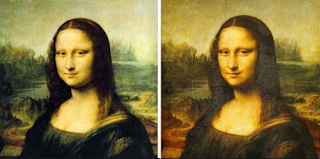Week 7: Neuroscience and Art
This week’s topic, neuroscience and art, was very fascinating
to me because it is all individualistic. For example, in Victoria Vesna’s lecture
one video she talks about how Franz Joseph Gall discovered the brain through twenty-seven
separate organs. These twenty-seven organs are shows on a phrenology chart. He
then compared the human brain to a brain of an animal and discovered we share nineteen
of these twenty-seven section, and only eight are human specific. This proves
that humans as a species are not too far off from animals, our brains are just
more developed. The then developed the idea that different parts of the brain
get bigger the more you use them. This explains why some people are better than
others at math, art, reading, writing etc. He then posed the theory that with
this idea, that certain parts of the brain are bigger the more they are used,
criminals could be caught through behavioral types.
Courtesy of: http://izquotes.com/quote/66022
In Victoria Vesna’s second lecture we talk about the idea
that the brain never sleeps. Sigmund Freud’s main focus is making the
unconscious conscious. His theory includes the idea that the unconscious mind
governs behaviors of the conscious mind. He even wrote an entire book “The
Interpretation of Dreams” talking about what the unconscious mind means about
the conscious mind. He came up with different names for these mindsets; the
unconscious mind is ID, the conscious mind is the ego and the conscience mind
is the superego. He has helped fields like phycology and psychobiology further
their research.
Courtesy of: phrenology chart-http://www.grafficalmuse.com/?p=1445
A more modern idea with neuroscience and art is the
discovery that certain taste and sounds can bring up certain memories. Many music
artist talk about how they remember what song or album inspired them to become involved
in the music industry. Everyone can relate to this idea. Many people find it
easy to remember the lyrics of songs that came out 10-20 years ago, yet they
cannot remember what they read in their textbook two hours ago. This is because
songs and sounds have memories stored in your brain. Personally, I can hear a
song and tell you what year it came out in because of the memories I have with
it. D.T. Max talks about his in his article Swann’s Hypothesis. He says that
this theory has been around forever, but was not confirmed until a few years
ago. Teachers here has caught onto this idea and have begun teaching with songs
and tones.
Courtesy of: http://www.jungleredwriters.com/2015/06/oh-kaye-chats-about-music-memories-and.html
McLeod, Saul. "Sigmund Freud." 's Theories. N.p., 2013. Web.
15 May 2016. <http://www.simplypsychology.org/Sigmund-Freud.html>.
Vesna, Victoria.
"Neuroscience-pt1.mov." YouTube.
UC Online Program, 17 May 2012. Web. 15 May 2016.
<https://www.youtube.com/watch?v=TzXjNbKDkYI>.
Vesna, Victoria. "Neuroscience-pt2.mov." YouTube. UC Online Program, 17
May 2012. Web. 15 May 2016.
<https://www.youtube.com/watch?v=TFv4owX3MZo>.
Vesna, Victoria. "Neuroscience Pt3." YouTube. UC Online Program, 16
May 2012. Web. 15 May 2016. <https://www.youtube.com/watch?v=E5EX75xoBJ0>.
Swann’s Hypothesis.” The New York Times. The New York Times,
03 Nov. 2007. Web. 10 May 2017.






Comments
Post a Comment